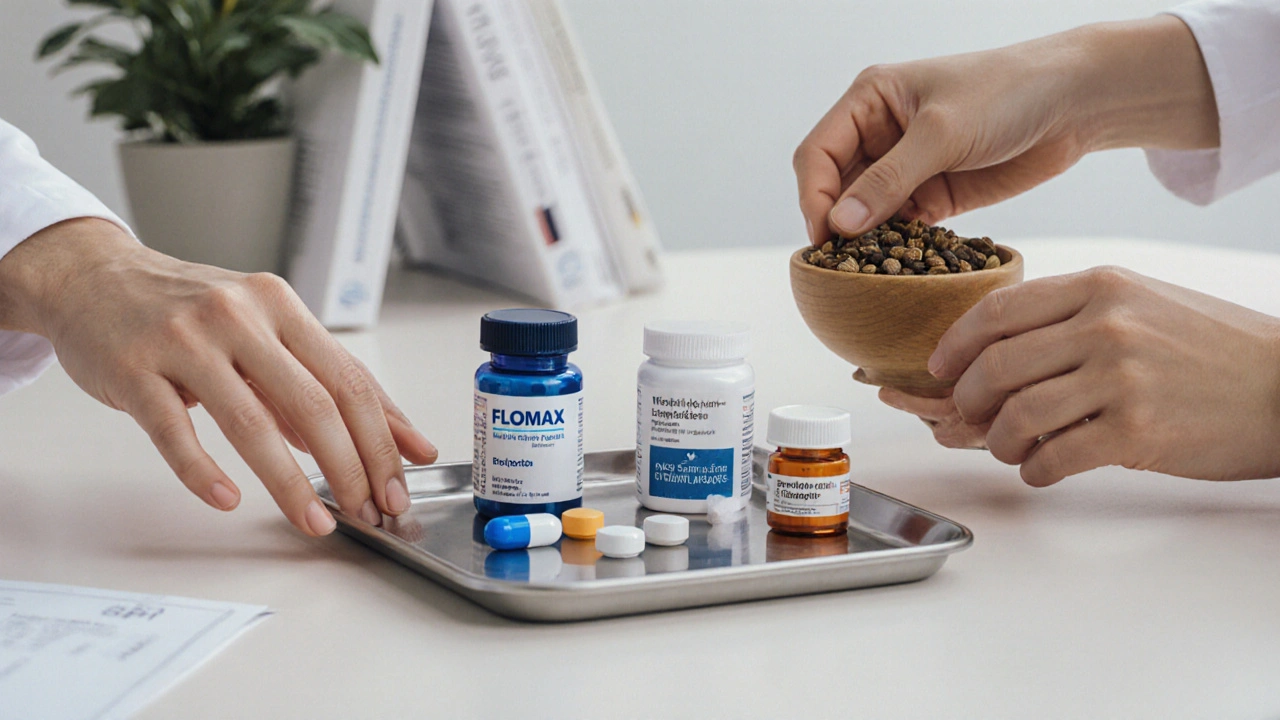
Health September 28, 2025
Flomax vs Other BPH Medications: A Comparison Guide
BPH Medication Comparison Tool
Compare BPH Medications
Select your preferences to see how different medications match your needs:
TL;DR
- Flomax (tamsulosin) is an alpha‑blocker that relaxes prostate muscle for easier urination.
- Alternative alpha‑blockers (alfuzosin, doxazosin, terazosin) work similarly but differ in dosing and side‑effects.
- 5‑alpha‑reductase inhibitors (finasteride, dutasteride) shrink the gland over months.
- Herbal options like saw palmetto may help mild symptoms but lack strong evidence.
- Choosing the right drug depends on symptom severity, prostate size, heart health, and cost.
When doctors talk about Flomax is a brand name for tamsulosin, a selective alpha‑1 adrenergic blocker that targets the prostate and bladder neck. It’s prescribed for benign prostatic hyperplasia (BPH) to ease urinary flow. While many men find relief, the drug isn’t a perfect fit for everyone, and that’s where Flomax alternatives come in.
What Is Benign Prostatic Hyperplasia?
Benign Prostatic Hyperplasia (BPH) is a non‑cancerous enlargement of the prostate gland that affects roughly 30% of men by age 60 and 70% by age 80. The extra tissue squeezes the urethra, causing frequent urination, weak stream, and nighttime trips to the bathroom.
Why Look for Alternatives to Flomax?
Flomax works well for many, but side‑effects like dizziness, retrograde ejaculation, and low blood pressure can be problematic. Some patients also have other health conditions-such as heart disease or low blood pressure-that make an alpha‑blocker risky. Cost can be a factor, too; generic tamsulosin is cheaper than the brand, yet insurance coverage varies across the UK. These concerns drive the search for other options.
Common Alternatives Overview
Below are the most frequently discussed drugs and supplements for BPH. Each belongs to a distinct therapeutic class and has its own profile of benefits and drawbacks.
- Alfuzosin - another alpha‑blocker with once‑daily dosing and less impact on blood pressure.
- Doxazosin - an older alpha‑blocker that also treats hypertension.
- Terazosin - similar to doxazosin, often prescribed when high blood pressure needs management.
- Finasteride - a 5‑alpha‑reductase inhibitor that shrinks the prostate over 6‑12months.
- Dutasteride - another 5‑alpha‑reductase inhibitor, a bit more potent than finasteride.
- Saw Palmetto - a herbal extract marketed for mild BPH; evidence is mixed.

Side‑Effect Snapshot
Understanding side‑effects helps you weigh each option against your lifestyle. Common complaints include:
- Dizziness or fainting - typical with alpha‑blockers (Flomax, Alfuzosin, Doxazosin, Terazosin).
- Sexual dysfunction - more frequent with 5‑alpha‑reductase inhibitors (Finasteride, Dutasteride) and can affect libido or cause erectile issues.
- Digestive upset - occasional with Saw Palmetto.
- Low blood pressure - a concern if you’re already on antihypertensives.
Cost Considerations in the UK
Generic tamsulosin (Flomax) typically costs £5‑£8 for a month’s supply under the NHS, but private prescriptions may be higher. Alfuzosin and doxazosin are similarly priced as generics. Finasteride costs around £2‑£4 per month, making it the most affordable long‑term option if prostate shrinkage is needed. Saw palmetto supplements range from £10‑£20 per month and are not covered by NHS.
Detailed Comparison Table
| Medication | Class | Typical Dose | Onset of Relief | Major Side‑effects | Prostate‑Size Impact | Typical UK Cost (NHS) |
|---|---|---|---|---|---|---|
| Flomax | Alpha‑blocker | 0.4mg once daily | Within days | Dizziness, retrograde ejaculation | No shrinkage | £5‑£8 |
| Alfuzosin | Alpha‑blocker | 10mg once daily | 1‑2weeks | Less dizziness, possible headache | No shrinkage | £6‑£9 |
| Doxazosin | Alpha‑blocker | 1‑4mg daily (split) | Within days | Orthostatic hypotension, fatigue | No shrinkage | £4‑£7 |
| Finasteride | 5‑alpha‑reductase inhibitor | 5mg once daily | 3‑6months | Decreased libido, erectile dysfunction | Reduces size ~20‑30% | £2‑£4 |
| Dutasteride | 5‑alpha‑reductase inhibitor | 0.5mg once daily | 3‑6months | Similar to finasteride, slightly higher sexual side‑effects | Reduces size ~25‑35% | £3‑£5 |
| Saw Palmetto | Herbal supplement | 320mg twice daily | 4‑8weeks (variable) | Generally mild; occasional stomach upset | Little to no measurable shrinkage | £10‑£20 (private) |
How to Choose the Right Option for You
Start by asking yourself three quick questions:
- Do I need immediate symptom relief or can I wait for a longer‑term solution?
- Is my prostate size moderate (<30g) or large (>30g)?
- Do I have low blood pressure, heart disease, or concerns about sexual side‑effects?
If you answered “immediate” and have a relatively small prostate, an alpha‑blocker like Flomax or Alfuzosin is usually the first line. If your prostate is large and you’re okay with a slower onset, a 5‑alpha‑reductase inhibitor (Finasteride or Dutasteride) can shrink the gland and may reduce the need for surgery later.
Patients on antihypertensive meds should discuss using doxazosin or terazosin with a GP, because the combined blood‑pressure‑lowering effect can cause fainting. Those worried about sexual side‑effects may prefer an alpha‑blocker or the herbal route, keeping in mind that evidence for Saw Palmetto is not as robust.
Finally, cost and prescription coverage matter. The NHS generally favours generic tamsulosin, alfuzosin, and finasteride. If you opt for a branded product or supplement, be prepared to pay out‑of‑pocket.
When to See a Doctor
If you notice any of the following, schedule a GP appointment:
- Sudden inability to urinate (acute retention).
- Blood in urine or semen.
- Persistent pain in the lower abdomen or back.
- Side‑effects that don’t improve after two weeks.
A doctor can perform a digital rectal exam, PSA test, and possibly an ultrasound to gauge prostate size-critical data for choosing the right medication.

Frequently Asked Questions
Can I switch from Flomax to an over‑the‑counter supplement?
You can, but it’s best to talk to your GP first. Supplements like saw palmetto may help mild symptoms, yet they don’t replace the muscle‑relaxing effect of an alpha‑blocker. A doctor can advise a safe tapering plan.
Is it safe to take two BPH drugs at the same time?
Sometimes a combination is prescribed-usually an alpha‑blocker plus a 5‑alpha‑reductase inhibitor. This can give quick relief and long‑term shrinkage. Only a clinician should decide, as the mix can increase side‑effects.
How long does it take for Flomax to start working?
Most men notice improved urine flow within a few days, though full symptom control can take up to two weeks.
What should I do if I experience retrograde ejaculation?
Retrograde ejaculation is a known effect of tamsulosin. It’s harmless but can affect fertility. Talk to your GP; they may switch you to an alternative alpha‑blocker with a lower risk.
Are there lifestyle changes that boost medication effectiveness?
Yes. Reducing caffeine and alcohol, staying hydrated (but not over‑drinking before bedtime), and regular pelvic‑floor exercises can all help. Losing excess weight also lessens pressure on the bladder.
Write a comment
Items marked with * are required.






8 Comments
Sadie Bell September 28, 2025 AT 10:18
Hey folks! If you’re feeling overwhelmed by all these meds, remember you’ve got options. Start with what feels right for your body and don’t be afraid to ask your GP for a trial period. You’ve got the power to take charge of your health – keep pushing forward!
Noah Bentley October 8, 2025 AT 20:18
Wow, a whole guide on BPH meds. Did anyone else notice the stray commas in the side‑effects column? Also, "retrograde ejaculation" – nice fancy term for "hey, you might lose some pleasure". Keep the English clean, please.
Kathryn Jabek October 19, 2025 AT 06:18
Dear fellow readers, I find this comparison most enlightening, particularly the nuanced discussion of alpha‑blockers versus 5‑alpha‑reductase inhibitors. The author’s systematic approach facilitates discerning the most suitable therapy based upon prostate size, cardiovascular status, and personal tolerance for sexual side‑effects. Moreover, the inclusion of cost considerations reflects a commendable awareness of practical constraints within the NHS framework. I would, however, suggest a deeper exploration of longitudinal outcomes, perhaps integrating data from the MTOPS and REDUCE trials to enrich the evidentiary base. In sum, a thorough exposition that prompts both reflection and informed dialogue.
Ogah John October 29, 2025 AT 15:18
Okay, so we’ve got alpha‑blockers for quick relief and the shrink‑ers for the marathon. My brain is doing cartwheels trying to balance immediate comfort against long‑term prostate reduction. If you’re low on blood pressure, maybe skip Flomax – it’s like adding a leaky hose to an already droopy faucet. And for the folks worrying about bedroom performance, the 5‑alpha‑reductase crew might be the party poopers you’re trying to avoid.
Kelvin Murigi November 9, 2025 AT 01:18
Let me break this down for anyone still parsing the table. First, alpha‑blockers such as Flomax, Alfuzosin, Doxazosin, and Terazosin work by relaxing smooth muscle in the prostate and bladder neck, which translates to an improvement in urinary flow within days. Their onset is rapid, but they do not change gland size. Expect side‑effects like orthostatic dizziness or, in the case of tamsulosin, retrograde ejaculation – a benign but often surprising outcome for patients.
Second, 5‑alpha‑reductase inhibitors (Finasteride and Dutasteride) target the hormonal pathway that converts testosterone to dihydrotestosterone, the driver of prostate growth. Because they shrink the gland, symptom relief is delayed, typically 3‑6 months, but the benefit is lasting. These agents carry a higher risk of sexual dysfunction, including decreased libido and erectile difficulty, which can persist even after discontinuation in a subset of men.
Third, herbal options like saw palmetto are widely marketed, yet randomized controlled trials provide mixed results. The evidence suggests modest symptom improvement in mild BPH, but the effect size rarely matches prescription‑grade medications, and the supplements lack standardization, leading to variable potency.
Now, to the practical side: cost. In the UK, generic tamsulosin sits at £5‑£8 per month, Alfuzosin around £6‑£9, while Finasteride is the cheapest at £2‑£4. Saw palmetto, being a supplement, can cost up to £20 per month and isn’t NHS‑covered.
When choosing a regimen, consider three key patient factors: symptom severity (do you need immediate relief?), prostate volume (large glands benefit more from shrink‑ers), and comorbidities (hypotension or cardiovascular disease may preclude certain alpha‑blockers). A combination therapy – an alpha‑blocker for quick flow improvement plus a 5‑alpha‑reductase inhibitor for long‑term size reduction – is often employed, but only under physician supervision due to the cumulative side‑effect profile.
Finally, lifestyle modifications complement pharmacotherapy. Limit caffeine and alcohol, maintain a healthy weight, and practice timed voiding to train bladder capacity. Pelvic‑floor exercises can also boost urinary control.
In summary, the choice hinges on the balance between rapid symptomatic relief and long‑term gland reduction, filtered through the lens of individual health status and financial considerations. Discuss these factors openly with your GP to arrive at a personalized plan.
ahmad matt November 19, 2025 AT 11:18
Alright this guide is pretty solid but let me point out the glaring omission of lifestyle factors that many docs love to ignore can you believe they never mention diet or hydration enough it feels like they just want you to swallow pills
kristine ayroso November 29, 2025 AT 21:18
Hey guys, just wanted to add that i read somewhere that drinking water after dinner can actually help with night time trips to the bathroom. Also i think its super important to talk to ur doc about any side effects, especially if u feel dizzy. Lets keep sharing tips!
Holly Hayes December 10, 2025 AT 07:18
Morals matter, dont take unnecessary meds